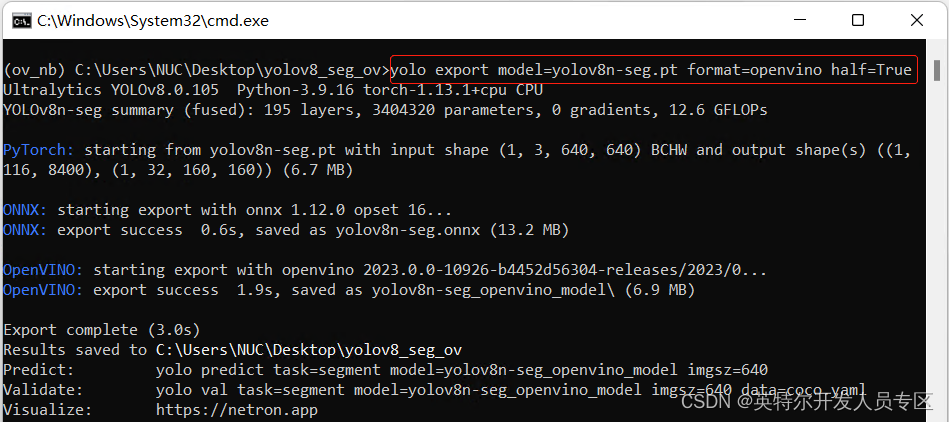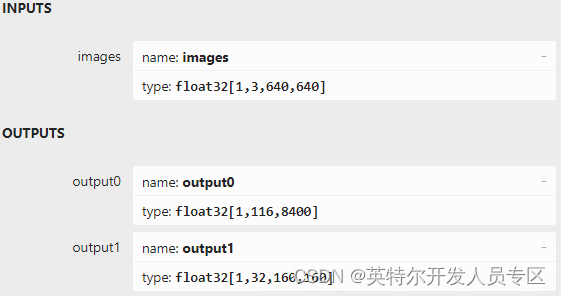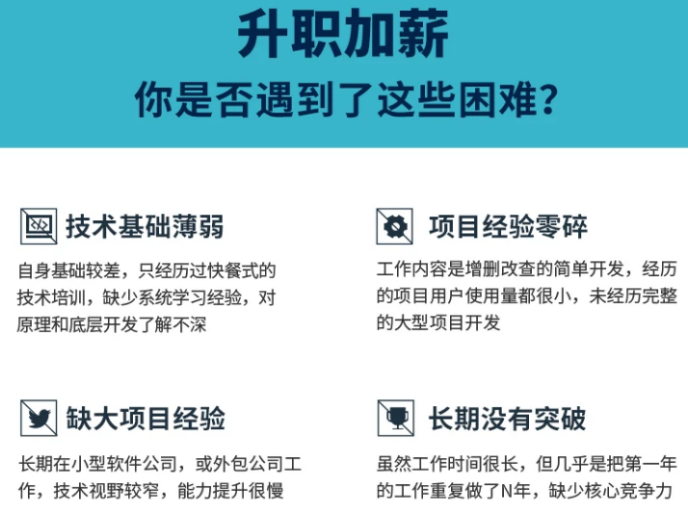
用OpenVINO C++ API编写YOLOv8-Seg实例分割模型推理程序
作者:英特尔创新大使 战鹏州本文章将介绍使用C++ API开发YOLOv8-Seg实例分割(Instance Segmentation)模型的AI推理程序。本文C++范例程序的开发环境是Windows + Visual Studio Community 2022,请读者。请克隆本文的代码仓:git clone https://gitee.com/ppov-nuc/yolov8_openvino_c
作者:英特尔创新大使 战鹏州
1.1 简介
本文章将介绍使用OpenVINO™ 2023.0 C++ API开发YOLOv8-Seg实例分割(Instance Segmentation)模型的AI推理程序。本文C++范例程序的开发环境是Windows + Visual Studio Community 2022,请读者先配置基于Visual Studio的OpenVINO C++开发环境。
请克隆本文的代码仓:git clone https://gitee.com/ppov-nuc/yolov8_openvino_cpp.git
1.2 导出YOLOv8-Seg OpenVINO IR 模型
YOLOv8是Ultralytics公司基于YOLO框架,发布的一款面向物体检测与跟踪、实例分割、图像分类和姿态估计任务的SOTA模型工具套件。
首先用命令pip install -r requirements.txt 安装ultralytics和openvino-dev。
然后使用命令:yolo export model=yolov8n-seg.pt format=openvino half=True,导出FP16精度的OpenVINO IR模型,如下图所示。

接着使用命令:benchmark_app -m yolov8n-seg.xml -d GPU.1,获得yolov8n-seg.xml模型在A770m独立显卡上的异步推理计算性能,如下图所示。

1.3 使用OpenVINO C++ API编写YOLOv8-Seg实例分割模型推理程序
使用OpenVINO C++ API编写YOLOv8-Seg实例分割模型推理程序主要有5个典型步骤:
- 采集图像&图像解码
- 图像数据预处理
- AI推理计算(基于OpenVINO C++ API)
- 对推理结果进行后处理
- 将处理后的结果可视化

YOLOv8-Seg实例分割模型推理程序的图像数据预处理和AI推理计算的实现方式跟YOLOv8目标检测模型推理程序的实现方式几乎一模一样,可以直接复用。
1.3.1 图像数据预处理
使用Netron打开yolov8n-seg.onnx,如下图所示,可以看到:
- 输入节点的名字:“images”;数据: float32[1,3,640,640]
- 输出节点1的名字:“output0”;数据:float32[1,116,8400]。其中116的前84个字段跟 YOLOv8目标检测模型输出定义完全一致,即cx,cy,w,h和80类的分数;后32个字段为掩膜置信度,用于计算掩膜数据。
- 输出节点2的名字:“output1”;数据:float32[1,32,160,160]。output0后32个字段与output1的数据做矩阵乘法后得到的结果,即为对应目标的掩膜数据

图像数据预处理的目标就是将任意尺寸的图像数据转变为形状为[1,3,640,640],精度为FP32的张量。YOLOv8-Seg模型的输入尺寸为正方形,为了解决将任意尺寸数据放缩为正方形带来的图像失真问题,在图像放缩前,采用letterbox算法先保持图像的长宽比,如下图所示,然后再使用cv::dnn::blobFromImage函数对图像进行放缩。

图像数据预处理的范例程序如下所示
Mat letterbox(const Mat& source)
{
int col = source.cols;
int row = source.rows;
int _max = MAX(col, row);
Mat result = Mat::zeros(_max, _max, CV_8UC3);
source.copyTo(result(Rect(0, 0, col, row)));
return result;
}
Mat img = cv::imread("bus.jpg");
Mat letterbox_img = letterbox(img);
Mat blob = blobFromImage(letterbox_img, 1.0/255.0, Size(640,640), Scalar(), true);1.3.2 AI同步推理计算
用OpenVINO C++ API实现同步推理计算,主要有七步:
- 实例化Core对象:ov::Core core;
- 编译并载入模型:core.compile_model();
- 创建推理请求:infer_request = compiled_model.create_infer_request();
- 读取图像数据并完成预处理;
- 将输入数据传入模型:infer_request.set_input_tensor(input_tensor);
- 启动推理计算:infer_request.infer();
- 获得推理结果: output0 = infer_request.get_output_tensor(0);
output1 = infer_request.get_output_tensor(1);
范例代码如下所示:
// -------- Step 1. Initialize OpenVINO Runtime Core --------
ov::Core core;
// -------- Step 2. Compile the Model --------
auto compiled_model = core.compile_model("yolov8n-seg.xml", "CPU");
// -------- Step 3. Create an Inference Request --------
ov::InferRequest infer_request = compiled_model.create_infer_request();
// -------- Step 4.Read a picture file and do the preprocess --------
Mat img = cv::imread("bus.jpg");
// Preprocess the image
Mat letterbox_img = letterbox(img);
float scale = letterbox_img.size[0] / 640.0;
Mat blob = blobFromImage(letterbox_img, 1.0 / 255.0, Size(640, 640), Scalar(), true);
// -------- Step 5. Feed the blob into the input node of the Model -------
// Get input port for model with one input
auto input_port = compiled_model.input();
// Create tensor from external memory
ov::Tensor input_tensor(input_port.get_element_type(), input_port.get_shape(), blob.ptr(0));
// Set input tensor for model with one input
infer_request.set_input_tensor(input_tensor);
// -------- Step 6. Start inference --------
infer_request.infer();
// -------- Step 7. Get the inference result --------
auto output0 = infer_request.get_output_tensor(0); //output0
auto output1 = infer_request.get_output_tensor(1); //otuput11.3.3 理结果后处理
实例分割推理程序的后处理是从结果中拆解出预测别类(class_id),类别分数(class_score),类别边界框(box)和类别掩膜(mask),范例代码如下所示:
// -------- Step 8. Postprocess the result --------
Mat output_buffer(output0_shape[1], output0_shape[2], CV_32F, output0.data<float>());
Mat proto(32, 25600, CV_32F, output1.data<float>()); //[32,25600]
transpose(output_buffer, output_buffer); //[8400,116]
float score_threshold = 0.25;
float nms_threshold = 0.5;
std::vector<int> class_ids;
std::vector<float> class_scores;
std::vector<Rect> boxes;
std::vector<Mat> mask_confs;
// Figure out the bbox, class_id and class_score
for (int i = 0; i < output_buffer.rows; i++) {
Mat classes_scores = output_buffer.row(i).colRange(4, 84);
Point class_id;
double maxClassScore;
minMaxLoc(classes_scores, 0, &maxClassScore, 0, &class_id);
if (maxClassScore > score_threshold) {
class_scores.push_back(maxClassScore);
class_ids.push_back(class_id.x);
float cx = output_buffer.at<float>(i, 0);
float cy = output_buffer.at<float>(i, 1);
float w = output_buffer.at<float>(i, 2);
float h = output_buffer.at<float>(i, 3);
int left = int((cx - 0.5 * w) * scale);
int top = int((cy - 0.5 * h) * scale);
int width = int(w * scale);
int height = int(h * scale);
cv::Mat mask_conf = output_buffer.row(i).colRange(84, 116);
mask_confs.push_back(mask_conf);
boxes.push_back(Rect(left, top, width, height));
}
}
//NMS
std::vector<int> indices;
NMSBoxes(boxes, class_scores, score_threshold, nms_threshold, indices);完整范例参考参见:yolov8_seg_ov_infer.cpp,运行结果如下图所示:

1.4 结论:
OpenVINO C++ API简单清晰,易学易用。本文用不到100行(不含可视化检测结果)C++代码就实现了基于OpenVINO的YOLOv8-Seg实例分割模型推理程序,在英特尔独立显卡A770m上获得了较好的推理计算性能。
更多推荐
 已为社区贡献10条内容
已为社区贡献10条内容










所有评论(0)